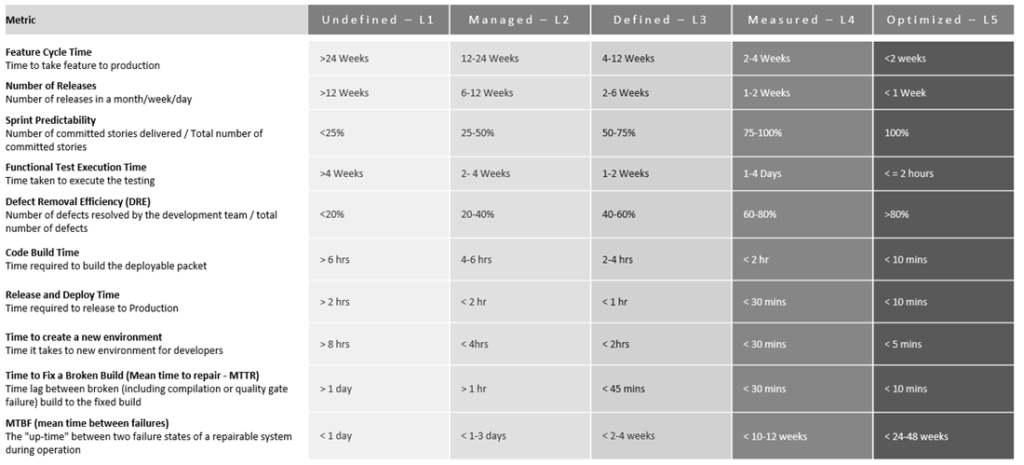Measuring & tracking the progress of any program is key to success as quoted in the famous saying:
If you can’t measure it, you can’t improve it.
Considering a large number of metrics available, this article summarizes the top ten metrics to measure from the delivery team’s productivity perspective:
| Metric | Purpose | Description |
|---|---|---|
| Feature Cycle Time | To measure the time-to-market of a feature to generate business value and denotes the velocity of the team. It also helps to find out inefficiencies within the team or technology, which can provide visibility to take strategic measures. | Cycle time from Definition of Doneness to Go Live. It is usually measured in days/weeks. Feature Cycle Time = Implementation End Date – Implementation Start Date |
| Number of Releases | To measure team’s ability to support time-to-market business needs | Number of releases in a month, week or a day |
| Sprint Predictability | To measure predicted vs. actual delivery commitment. Program management can use this metric to improve future Sprint’s projection & improve upon providing more realistic timelines to senior stakeholders. | Number of committed stories delivered / Total number of committed stories |
| Functional Test Execution Time | To measure the time taken to run the progression testing suite as well as regression testing suite. The shift-left strategy applied to ensure functional testing is fast to detect issues early. | Time taken to execute the testing suite (progression & regression) |
| Defect Removal Efficiency (DRE) | To measure the productivity of the development team to remove defects prior to release. | Number of defects resolved by the development team / total number of defects at the moment of measurement. DRE= (Number of defects found internally/ Number of defects found internally + Number of defects found externally) × 100 |
| Code Build Time | To measure the DevOps maturity level and ensure that team’s efficiency is not impacted by it. | Time required to build the deployable packet, passing all gates of Continuous Integration cycle (incl. code quality, security & performance testing, sanity testing, etc.) |
| Release and Deploy Time | To measure the DevOps maturity from a continuous deployment perspective. | Time required to release the packet on production like cluster and bringing the services back for use. |
| Time to create a new environment | To measure the DevOps maturity to build a new environment to enable the development team to focus on issue resolution. The process should be as close to possible as used for a production environment. | Time it takes to new environment for development team. It is measured in minutes or seconds. |
| Time to Fix a Broken Build (Mean time to repair – MTTR) | It reflects how quickly an organization or team can respond to system issues or defects and fix them. It also denotes the architecture & design maturity to enable the team to resolve issues quickly. | Time lag between broken (including compilation or quality gate failure) build to the fixed build. MTTR = Total time to repair / Total number of repairs |
| MTBF (mean time between failures) | To measure the reliability of the system and architecture & design maturity of the system under consideration. It measures how effectively the team is using SRE practices. | The “up-time” between two failure states of a repairable system during operation. It is typically represented in hours. The higher the MTBF number is, the higher the reliability of the system. MTBF = Total uptime / # of breakdowns |
You can also measure the maturity level of your practices for the above metrics. Maturity model definition can vary as per your organization and here is a sample maturity model definition for reference:
Follow @ankurkumarz Follow @VedcraftTeam


thanks for the list. one thing we are struggling on measuring the productivity of the labs is that each project/product is different. also each metric alone contains ambiguity ( or lab can game the system). The ultimate goal for us is to find a best balance point of speed and quality which we call it “definition of good-enough”. It is a art than science.
We also measure a few more items.
– wait time between QA sign-off and deploy to prod. This is to help us to identify the wait time. It is not so much a issue for the lab, but it is a agility issue.
— prod Incident frequency: This is to measure how often end user experience the issue. of cause the less the better.
— unit testing time spent: It is a dilemma. some developer does not do enough unit testing. we cannot say shorter is better. there is no clean cut.
— No touch operation: This is to measure how busy our op team is. Ideally they should not be busy to duck-tape the system here and there to keep it running.
Hi, I didn’t found any reference for Maturity Model for Productivity Metrics, where Can I find the rationale behind those numbers?